SEO vs. GEO: Where Should You Focus Your Budget
Key Takeaways
- Focus your budget on SEO fundamentals that drive proven business results and naturally position you for generative engine optimization as AI search platforms grow.
- Smart marketers are developing SEO strategies that work across all search environments without needing separate budgets or dedicated GEO tactics, emphasizing the importance of quality content.
- Content strategies for attracting customers remain consistent across Google's traditional results, AI Overviews, and standalone AI platforms, as shown through an example of a bride's search for a wedding dress designer.
The short answer: Focus your budget on SEO fundamentals that drive proven business results. The good news? These same strategies naturally position you well for generative engine optimization (GEO) as AI search platforms continue growing.
While Google organic search still drives 40-60% of traffic for most businesses compared to less than 1% from standalone AI platforms like ChatGPT and Perplexity, smart marketers are building SEO strategies that work across all search environments. You don’t need separate budgets or dedicated GEO tactics – you need quality content that explains what your product or service does, who it’s for, and what problems it solves.
I love how Brian Sierakowski, the co-founder of Changebot AI, puts it in this X post. He said:
“…talking about your own products, the improvements you’re making, and why those improvements make your customers more money will continue to engage and convert the right people“
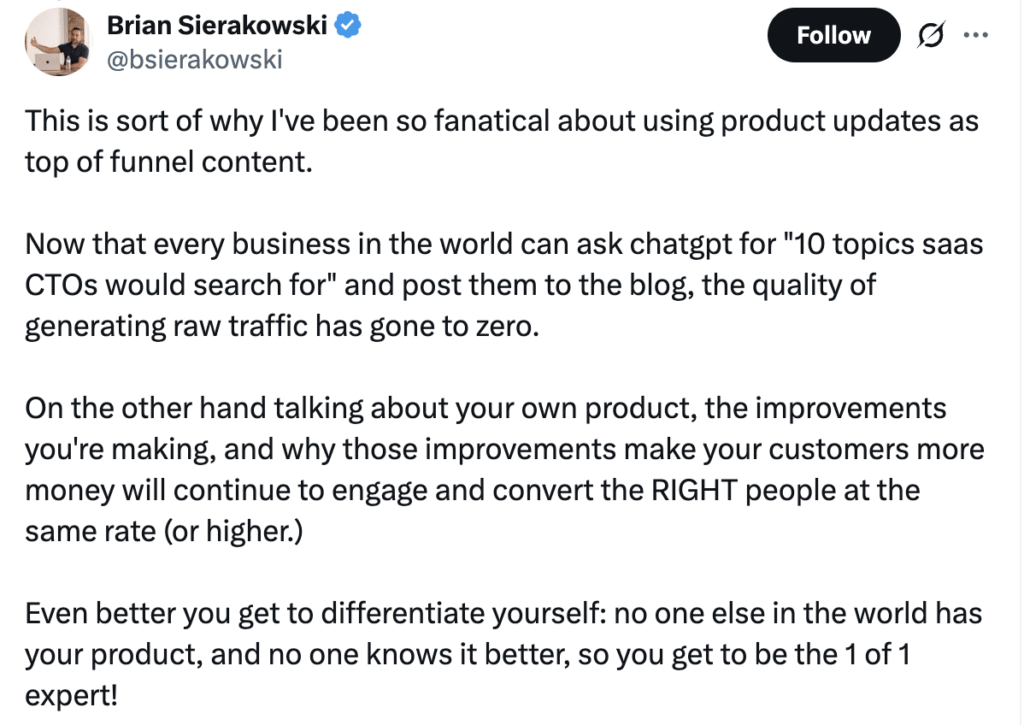
This approach works whether people find you through Google’s traditional results, AI Overviews, or standalone AI platforms. For example, a bride looking for a wedding dress designer might search differently across platforms, but the underlying content strategy remains the same.
In Google, she might type “custom wedding dresses near me.” But in a generative search engine like ChatGPT, she can provide more context:
“I’m a bride getting married in Charleston, South Carolina, in October, and I need a bespoke satin A-line wedding dress with off-the-shoulder sleeves, designed for a curvy figure, that can be completed within six weeks. Can you recommend any local bridal boutique near me with good reviews?”

An AI assistant will search for brands that have published detailed content about their specific services, capabilities, and strengths. The businesses that get recommended have invested in comprehensive content that serves both traditional SEO and positions them well for AI discovery.
How SEO and GEO Overlap (And Where They Differ)
Understanding the similarities and differences helps you allocate resources effectively while building for both current and future search behaviors.

1. Authority Building: Same Foundation, Broader Reach
Traditional search engines reward topical authority through high-quality, relevant content. The more comprehensive coverage you have of your expertise area, the better you tend to rank and attract organic traffic.
GEO follows similar principles, but with an important distinction: AI platforms pull from a broader range of sources. While Google primarily indexes websites, AI systems gather information from YouTube, social media, documentation, forums, books, and podcasts through Retrieval Augmented Generation (RAG).
This means the SEO fundamentals you’re already doing – creating quality content that demonstrates expertise – work for AI platforms too. But AI tools also consider your brand mentions and presence across multiple channels when determining what to cite.

Take Google’s AI mode, which launched with over 50 billion product listings. When users search for specific products, Google’s AI scans listings to find close matches to user queries. Products with detailed descriptions of what they do and how they help customers get surfaced more often.
The businesses succeeding here aren’t using special “AI optimization” tactics – they’re providing comprehensive product information that serves customers and search algorithms alike.
2. Content Strategy: Quality Over Quantity, Context Over Keywords
Traditional SEO requires optimizing both front-end and back-end elements: keyword research, technical SEO, backlinks, user experience optimization. Everything aims to make your site crawlable and valuable for users.
GEO benefits from this same foundation but emphasizes clear communication about your brand’s purpose and capabilities. Since AI tools analyze content semantically rather than just matching keywords, detailed explanations of what you do and how you help customers become more important.
However, this doesn’t mean abandoning proven SEO practices. The businesses getting cited in AI responses typically have strong domain authority, quality backlinks, and technical excellence – the same factors that drive Google rankings.
As Ahrefs research shows, brand mentions correlate with appearance in AI overviews. But this happens naturally when you build authority through consistent, quality content across channels, not through dedicated “brand mention” campaigns.
3. Metrics: Current vs. Future Tracking
Your measurement approach should reflect current traffic realities while preparing for future growth:
Current Priority (Traditional SEO)
- Organic traffic and rankings
- Click-through rates and conversions
- Revenue and lead generation from Google
Future Monitoring (GEO)
- Brand mentions in AI responses
- Traffic from AI platforms (currently minimal for most sites)
- Citation tracking across AI tools
Since standalone AI platforms drive less than 1% of traffic for most businesses, your primary metrics should focus on Google organic performance while monitoring AI developments for future planning.
4. Query Evolution: Preparing for Natural Language
Traditional SEO targets shorter, keyword-focused queries averaging 3-4 words according to SEMRush data. AI platforms encourage longer, more conversational queries because users can provide detailed context.
The wedding dress example illustrates this perfectly. Instead of optimizing for “custom wedding dresses,” smart businesses create content addressing specific scenarios, timelines, and customer needs that might appear in detailed AI queries.
But this doesn’t require separate content strategies. Comprehensive content that addresses customer questions naturally performs well for both short keyword queries and detailed conversational searches.
Where to Invest Your Budget: A Data-Driven Approach
At HigherVisibility, we help clients focus their resources where current traffic and conversions actually come from, while building foundations that work across emerging platforms.
1. Prioritize High-Impact Content Refreshes
Ahrefs analyzed over 17 million citations across 7 AI search engines and found they prefer content that’s 25.7% fresher than average. ChatGPT shows the strongest preference for recent content, typically citing pages less than 3 years old.
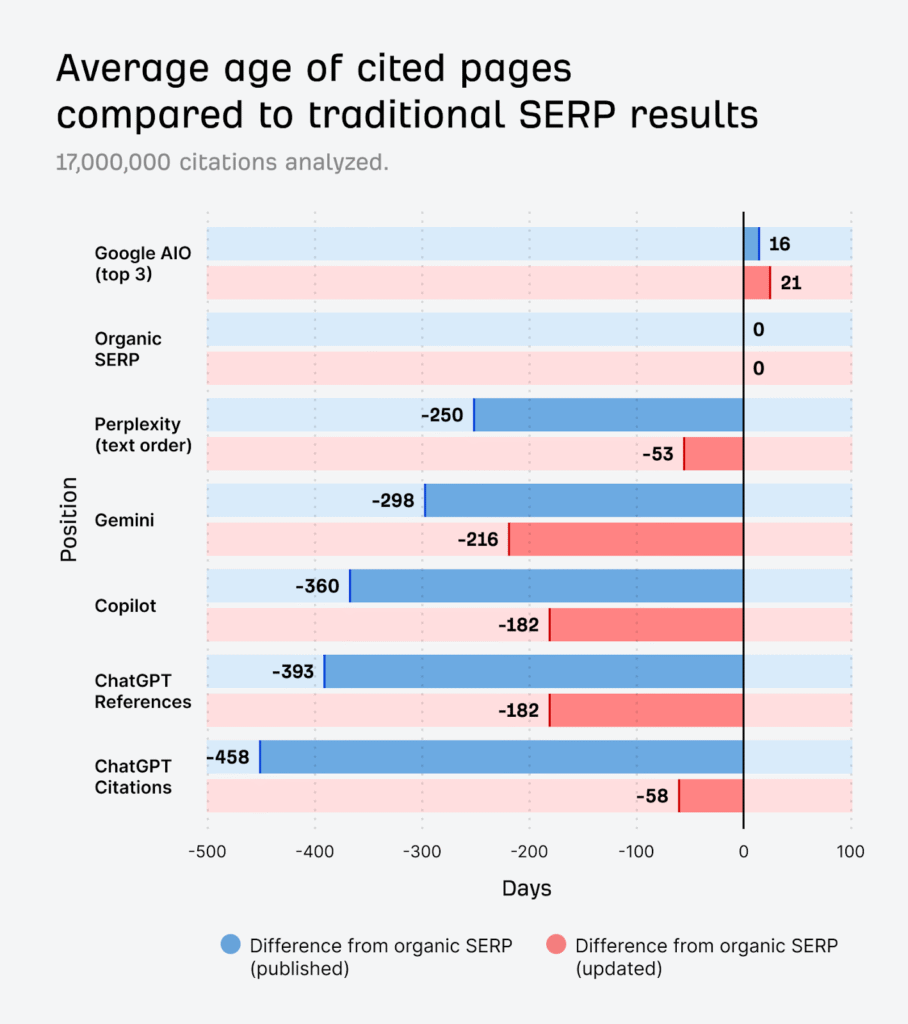
This aligns with what we’ve always known about Google – fresh, updated content tends to perform better. The difference is that maintaining current content now serves both your primary traffic source (Google) and positions you well for AI citations.
For instance, at HigherVisibility, we regularly refresh client content to add new data, case studies, and insights. When we updated our “Types of Franchise Models Explained” content in 2025, it ranked first on Google for our target keyword. When the same query appears in Perplexity or ChatGPT, our content gets cited because it provides comprehensive, current information.
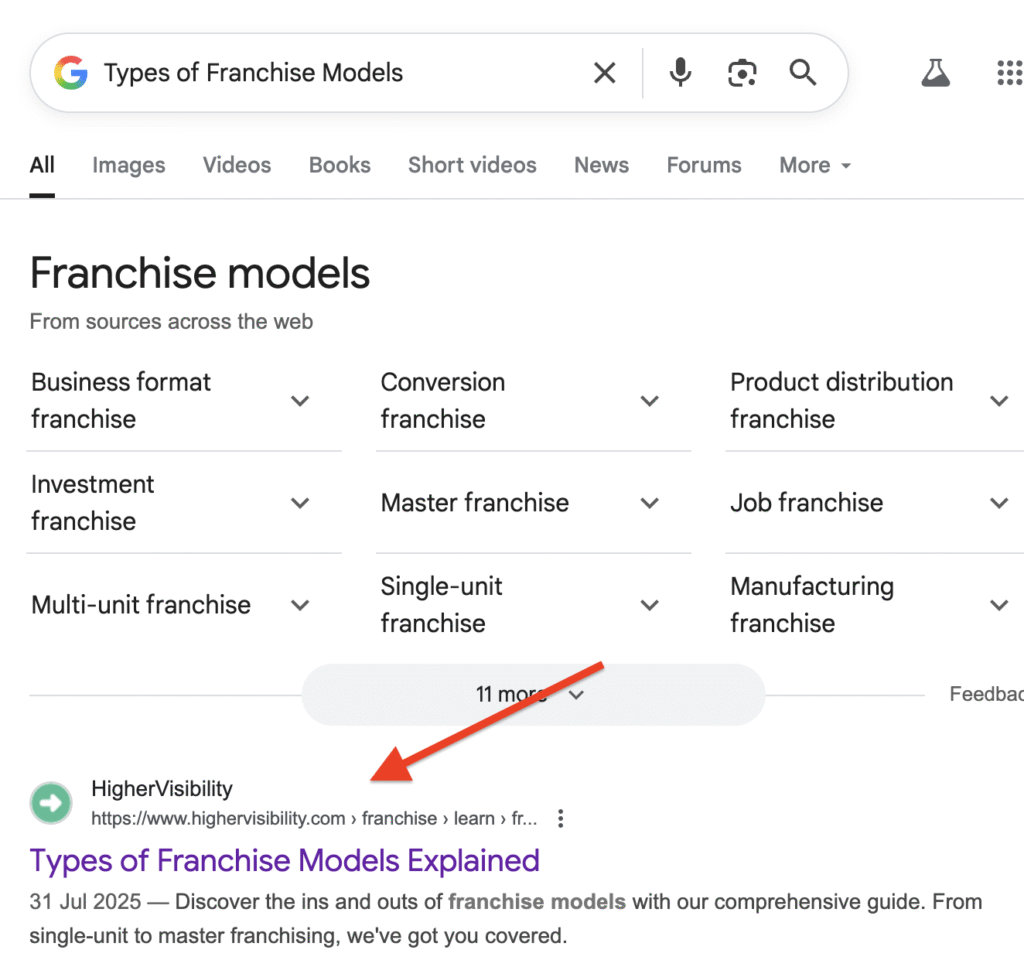
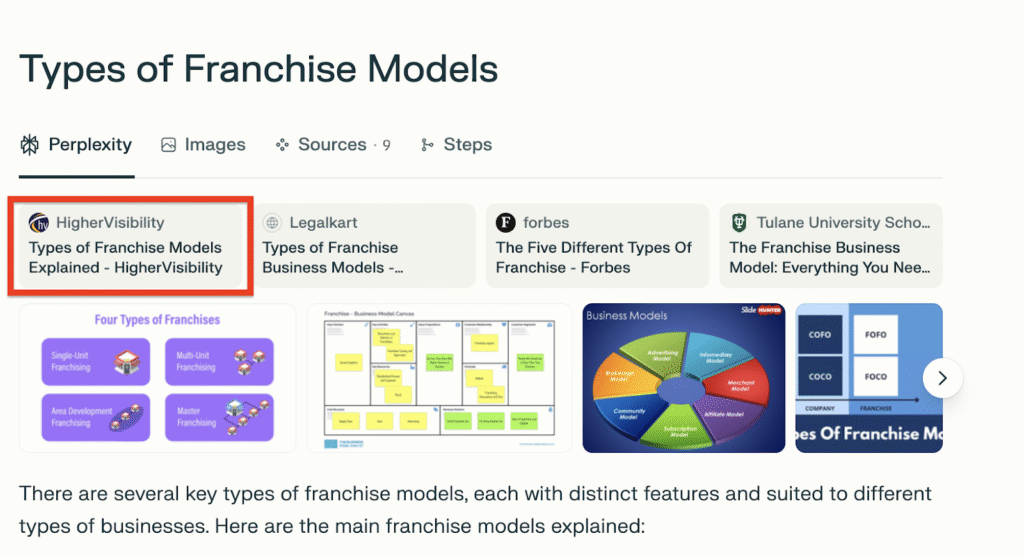
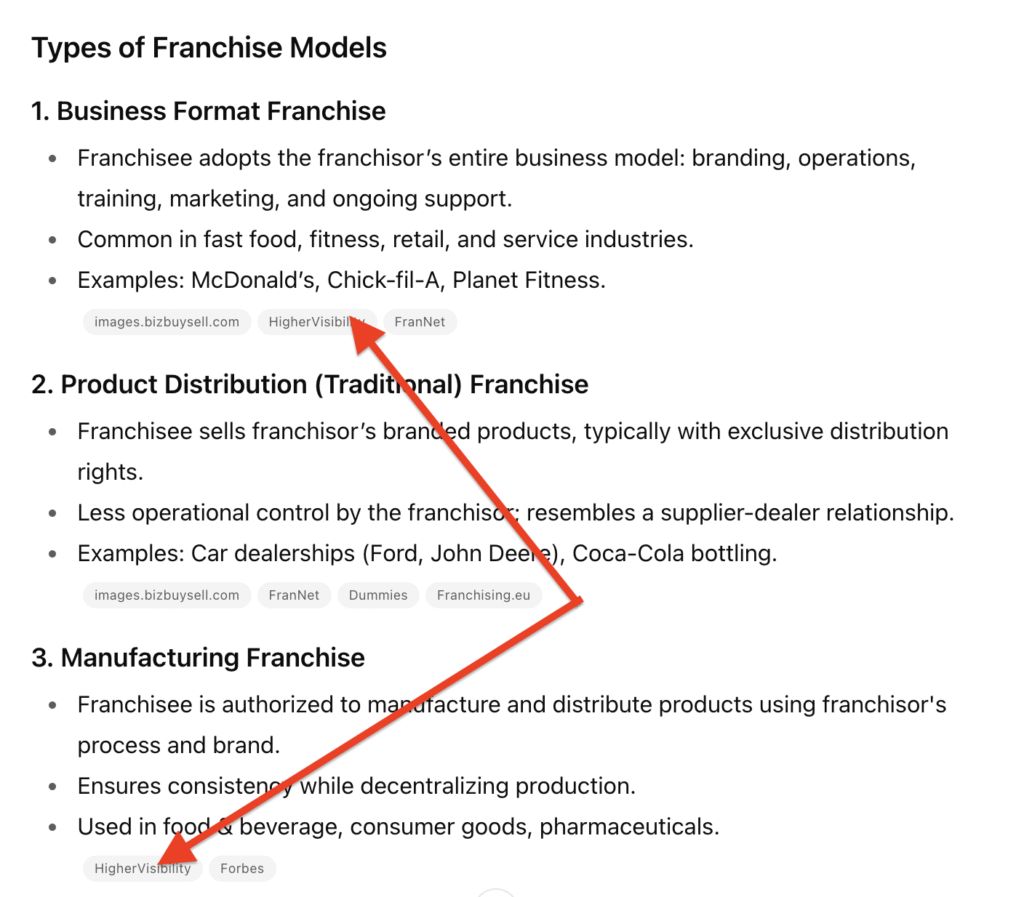
SurferSEO research confirms this approach. They analyzed 100 blog posts and found that content covering more facts gets better visibility and ranks for more keywords – exactly what both traditional search engines and AI platforms reward.
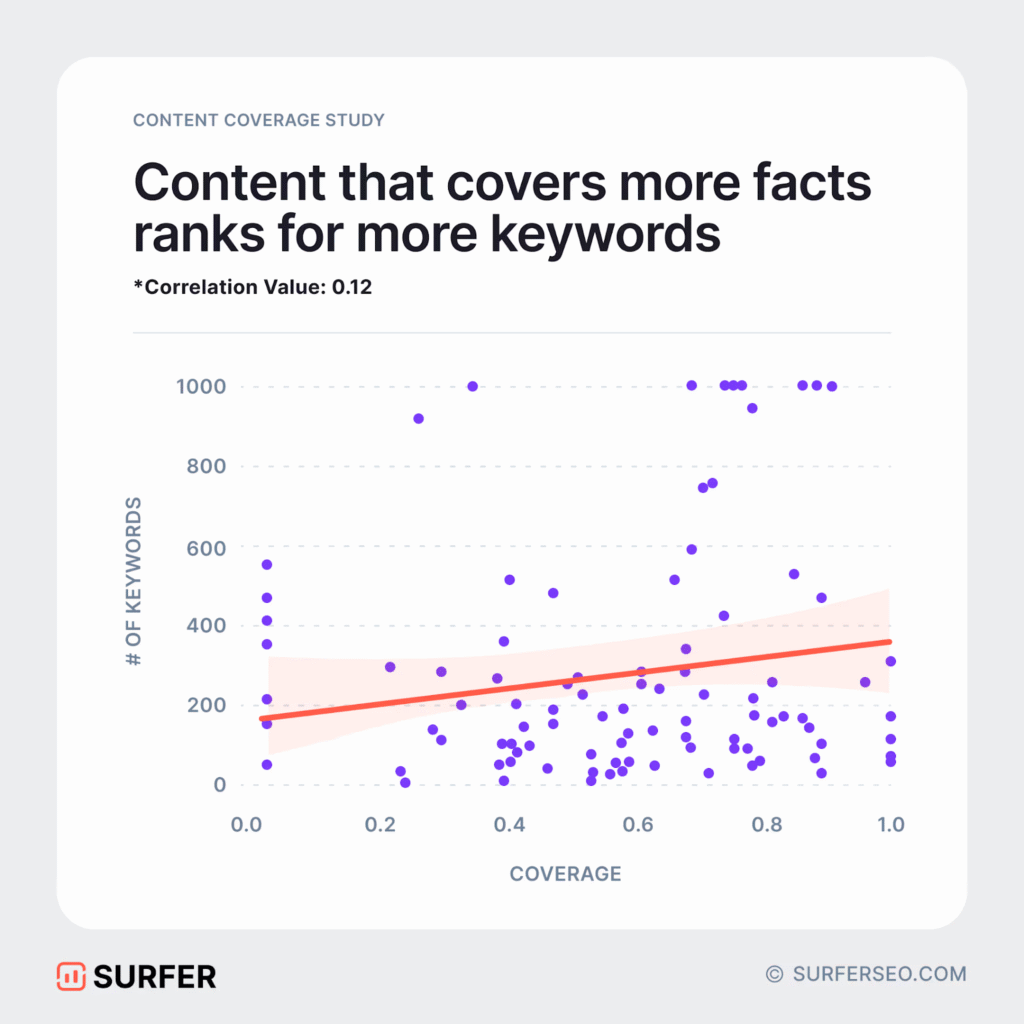
Budget allocation tip: Start with your highest-converting pages that already drive business results. Refreshing successful content typically provides better ROI than creating new content from scratch.
2. Focus on Product-Led Content That Serves Business Goals
Create bottom-funnel content that clearly explains:
- What your product or service does
- Core features and capabilities
- Target audience and use cases
- Specific problems solved and outcomes delivered
This content strategy works because it directly supports your business goals while positioning you for AI discovery. When someone asks an AI tool for specific product recommendations, detailed content about your offerings makes you more likely to be cited.
Ahrefs analyzed 35K pages receiving AI traffic and found that brand-focused content like product pages, comparisons, and “best of” lists perform well. When they examined their own traffic, 80% went to their tools, homepage, and product pages.
This doesn’t mean abandoning educational content, but it does suggest prioritizing content that connects to business outcomes. AI platforms are more likely to recommend specific solutions than provide general information without sources.
Budget allocation tip: Since AI tools often provide general information without citations, focus content investment on topics where your specific expertise or product provides unique value.
3. Structure Content Around Natural Questions
SEMRush analyzed over 10M keywords and found AI Overviews appear most often for long-tail, informational queries. This happens because AI systems interpret natural language and contextual intent rather than just matching keywords.
Use People Also Ask questions and FAQ structures in your content, but frame them around your expertise area rather than creating general informational content. When AI platforms break complex queries into sub-questions, well-structured content that directly answers these questions gets cited more often.
This approach serves both traditional SEO (featured snippets, PAA boxes) and AI platforms that scan for direct answers to user questions.
Budget allocation tip: Structure existing high-performing content with clear headings and FAQ sections rather than creating separate “AI-optimized” content.
The Reality Check: Current Traffic vs. Future Preparation
While these strategies position you well for AI search growth, your budget allocation should reflect current business realities:
Primary investment (80-90%): Google organic optimization that drives actual traffic, leads, and revenue today.
Future preparation (10-20%): Content enhancements and structural improvements that naturally work for AI platforms as they grow.
Kenichi Suzuki, a Google search advocate, puts it perfectly: “To get your content to appear in AI Overviews, simply use normal SEO practices. You don’t need GEO, LLM optimization, or anything else.”
Ryan Law, VP of content at Ahrefs, agrees: “There’s a massive overlap in SEO and GEO, such that it doesn’t seem useful to consider them distinct processes. The things that contribute to good visibility in search engines also contribute to good visibility in LLMs. If you want to increase your presence in LLM output, hire an SEO.”
Final Thoughts
Your SEO strategy should prioritize what drives business results today while naturally positioning you for tomorrow’s search evolution. Google organic search remains the primary driver of traffic and conversions for most businesses, making it the logical focus for budget allocation.
The strategies that build authority, trust, and visibility in traditional search – comprehensive content, technical excellence, user focus, also happen to work well for AI platforms. You don’t need separate budgets or specialized tactics; you need consistent execution of SEO fundamentals that serve both current and emerging search behaviors.
